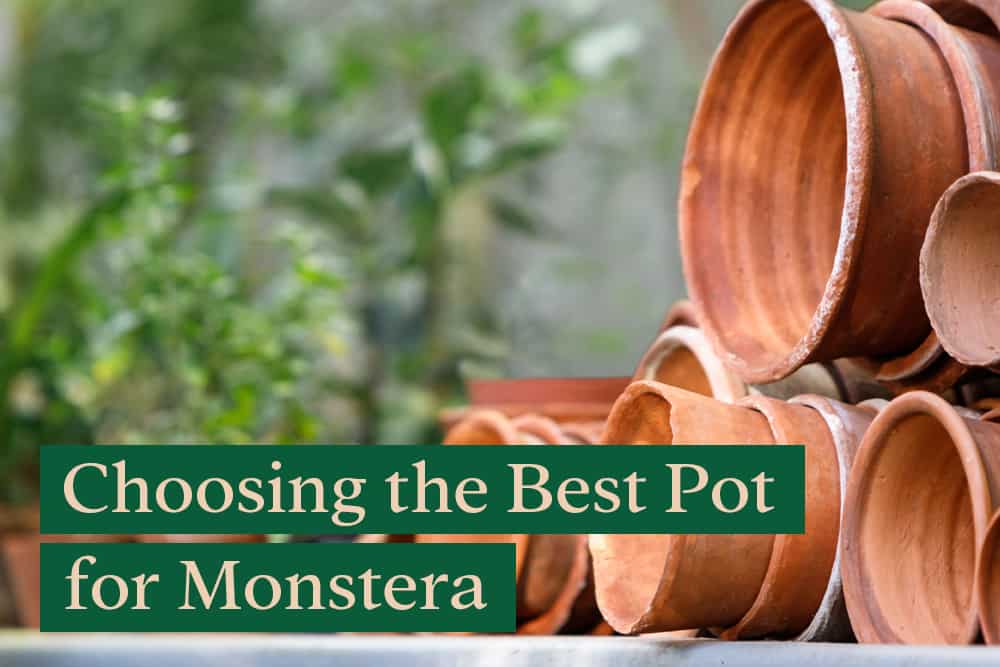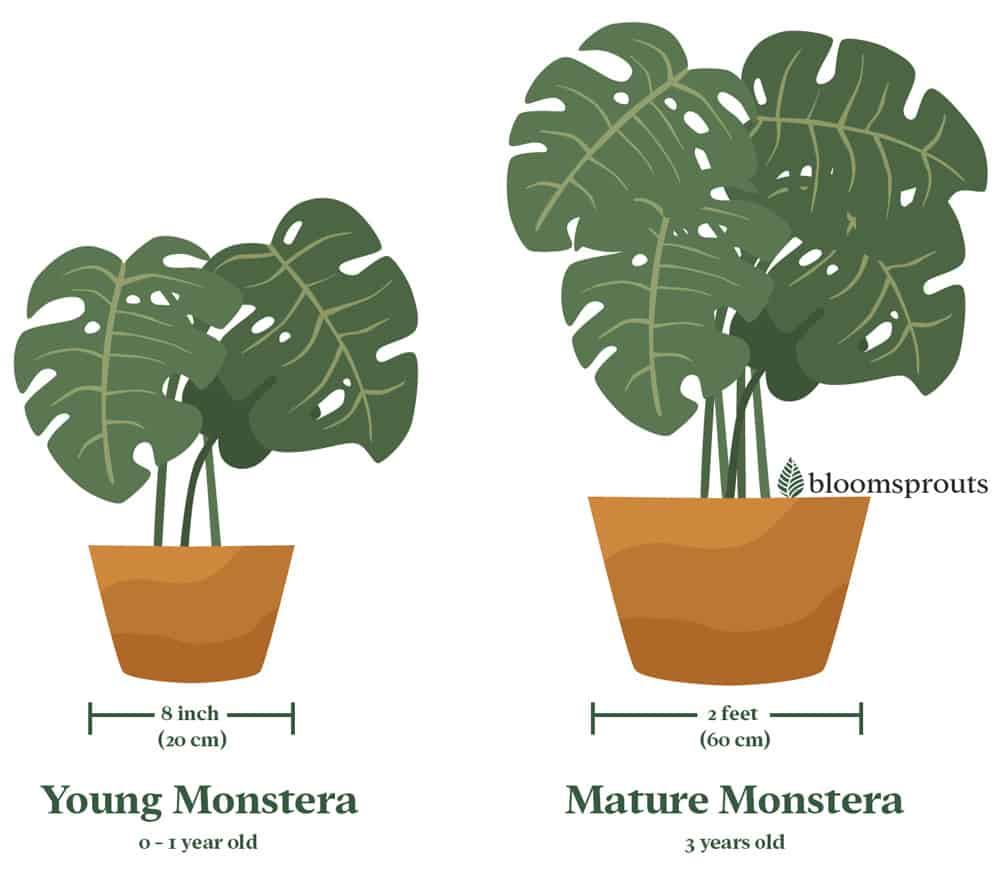
There are so many different kinds of pots, how do you know which one to pick for your Monstera?
Monstera needs a pot with good drainage that will allow the soil to drain freely. The material you choose for your Monstera’s pot will depend on a few different factors such as how much water it gets and what kind of climate it lives in. The pot should be deep enough to support a stake or moss pole for your Monstera to climb up.
Keep reading to find out more about choosing the best pot for your Monstera:
- Considerations when choosing a pot for your Monstera
- What pot size is best for Monstera?
- The best material for your Monstera Pot
Considerations When Choosing a Pot for Your Monstera
Before you go to the store (in person or online) to look at pots, you should have an idea of what kind of pot to get for your Monstera. There are a few things you need to consider that will determine the best material and style for your Monstera’s new home.
You need to think about:
- Drainage
- Watering habit
- Temperature and climate
- If your Monstera lives inside or outside
Drainage is a Must
Your Monstera’s pot must have drainage. Monsteras do not like their soil to stay wet for too long, as they are susceptible to root rot.
A pot without drainage, also called a cachepot, will hold onto extra water at the bottom and increase the likelihood that the roots start to rot.
But there’s one problem, cachepots tend to be the prettiest pots!
There are two things you can do if you insist on using a cachepot for your Monstera:
- Drill a hole in the bottom, or
- Put your Monstera in a plastic nursery pot inside the pretty cachepot.
It is not recommended to pot your Monstera directly into a cachepot with no drainage unless you are absolutely confident you know precisely how much water it needs.
Watering Habit
Do you tend to overwater or underwater your plants? The answer will determine what kind of pot you should get for your Monstera.
Pots for Overwaterers
Most plant moms tend to be overwaterers. When this is the case, the best pot for your Monstera is one that will drain freely so that there is no standing water. Monsteras are very susceptible to root rot when their soil is too wet for too long.
Terracotta is a good pot material to consider for your Monstera, if you tend to overwater it because terracotta is porous and will wick away extra moisture.
Pots for Underwaterers
Do you tend to neglect your plants? Do you let them droop before you remember to water them? That’s okay!
Materials like plastic and glazed terracotta will keep moisture in the soil for longer than unglazed terracotta.
Even if you underwater your Monstera, you should never put it in a pot without any drainage.
| Watering Habit | Monstera Conditions | Recommended Pot |
|---|---|---|
| Over-waterer | • Soil too wet for too long • Tends to develop root rot | • Terracotta pot |
| Under-waterer | • Not enough water as it evaporates • Monstera leaves droops | • Plastic pot |
Also read: How often should you water a Monstera?
Temperature and Climate
Your area’s climate and temperature will affect your Monstera plant. Here’s how to choose a pot based on your climate.
Humid vs Dry
Monsteras are from the jungle. They love humidity! As long as the air is humid, they would be happy in a pot like terracotta that dries out a little bit faster.
If you live in a dry area, or your Monstera is inside for the winter, it will need a pot that holds in a little more moisture, such as plastic or glazed terracotta.
Are you starting to see a pattern?
Hot vs Cold
In a hot climate, your Monstera is going to need water more often, so a pot that retains water will help keep it from getting thirsty.
In a cold climate, your Monstera is not going to need as much water, so there is a greater chance for overwatering.
Drainage holes are extra important, as well as free-draining soil mix. Terracotta would help keep your Monstera from getting overwatered in the cold.
| Temperature | Monstera Needs | Recommended Pot |
|---|---|---|
| Hot | • Water evaporates faster • Pot needs to retain water | • Plastic pot • Metal pot |
| Cold | • Monstera doesn’t need as much water • Water evaporates slowly | • Terracotta pot |
Growing Indoor or Outdoor
Growing your Monstera indoor or outdoor will also determine what kind of pot you’ll need.
Inside, you control how much water your Monstera gets. Your Monstera is protected from harsh sun and wind as well. You may use a cachepot indoors to use your Monstera to increase the beauty of your home.
Outside, your Monstera will be impacted by your climate. Do you live where there is lots of sun? What about rain? Is it windy where you live?
No matter the weather, your Monstera will likely get more sun than it would be indoor, which will increase its growth rate and water intake.
If you live somewhere rainy, your Monstera’s pot needs to have lots of extra drainages. Do not use a cachepot for your Monstera if it is going to live outside for any length of time.
Increasing the amount of perlite or sand in your Monstera’s potting mix will also help it drain better when it rains a lot.
If it is hot and sunny, you will want your Monstera in a pot that will hold onto water for a little longer, like plastic or glazed terracotta.
If it is windy, you want to make sure your pot is heavy enough that your Monstera will not fall over. Plastic pots will be too light for a mature Monstera.
You could even place a couple of heavy rocks in the bottom of the pot to keep it balanced. Too much wind might damage your Monstera’s leaves, so it would be best to bring it inside during very windy weather.
Which Pot Size to Buy for Monstera
The size pot your buy for your Monstera will depend on how big your Monstera is.

If your Monstera is still a baby, it will need smaller pot, no more than 8 inches (20 cm) in diameter. A mature Monstera can get to a pot size of up to two feet (60 cm).
Depending on how fast your Monstera grows, it will need to be re-potted every one to three years.
Read on to find out more about picking the perfect pot size for your Monstera.
Problems with Oversized Pot
A pot that is too big for your Monstera will hold onto too much moisture. Areas in the soil with no roots will stay wet for too long, which can lead to root rot.
Monsteras do not like wet feet, so it is important not to put them in a pot that is too big.
Also Read: Other Factors Causing Root Rot in Monstera? and How to Prevent It
Problems with Pot that is too small
Alternatively, it would be best if you didn’t put your Monstera in a pot that is too small. Here are some signs that your Monstera is ready to be re-potted:
- The plant is top-heavy or falls over
- Leaves are droopy and thirsty
- The soil dries out too quickly or doesn’t hold onto water anymore
- You can see roots poking out the bottom of the pot
Especially when Monstera is young, living in a pot that is too small can lead to root crowding, stunted growth, and underwatering. Time to find a bigger pot!
A mature Monstera is okay with being a little pot-bound. Once your Monstera has reached a large size, and you don’t want it growing too much bigger, keeping it in the same size pot will prevent it from growing so rapidly.
It will still need the care to keep from getting too pot bound. You can prune the roots and top-dressing your Monstera with fresh soil every year in the early spring.
How to choose the perfect pot size
When re-potting, choose a pot that is 2 inch (5 cm) larger in diameter from current size. This is enough to let its roots grow and expand, but not so much that the soil will become waterlogged from a too-big pot.
Does the height of the pot matter?
Most pots are not significantly different in their height-depth ratio. Monsteras are not too picky about the depth of their pot.
Do make sure your Monstera’s pot is deep enough to support a stake or moss pole from falling over.
Deciding the Pot Material for Monstera
There are many different materials used to make plant pots.
Your Monstera’s living conditions (climate, how much water, etc.) will determine what pot will keep it the happiest.
Clay or Terracotta
Unglazed clay or terracotta is the best pot for when your Monstera gets a lot of water and needs to dry out faster.
Choose this material if you tend to overwater your plants or if your Monstera is going to live outside in a rainy area.
But note that, your beautiful orange terracotta pots can easily turn white due to a process called efflorescence.
Plastic
Plastic is the most common and cheapest kind of pot. Plastic will help keep in moisture and is a very light material.
Choose this material if you live somewhere drier, if you don’t water your Monstera too much, or if you are planning on moving it around.
Ceramic
Ceramic pots are the prettiest. There are so many different designs, and they fit in with any kind of home decor. These pots most likely have no drainage hole, which is a problem for Monsteras.
Ceramic pots work best as a cachepot while your Monstera is in a plastic nursery pot with drainage inside.
Choose this material if you are okay spending a little more money to give your Monstera a beautiful home.
Concrete
Concrete pots are the best for very big, mature Monsteras, as they are very heavy and will keep your plant from falling over.
Concrete pots can be used indoors or outside, but you probably don’t want to move them very often due to their weight. Like ceramic pots, concrete pots may or may not have drainage holes. Keep this in mind as you shop.
Wood
Wooden pots come in a wide variety of styles and sizes. Like terracotta, unfinished wood will wick away extra moisture from your Monstera’s soil.
Wooden pots are lighter than clay, ceramic, or concrete, so they are easier to move around when necessary.

